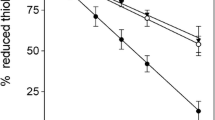Abstract
A series of aliphatic and aromatic aldehydes and ketones, as well as some nitrocompounds were reduced using whole plant cells from Lens culinaris seeds. In addition, we also investigated the possibility of enzymatic ester hydrolysis to explore the potential of these seeds. The reduced ketones products were obtained in yields of 8 ∼ 82% and enantiomeric excess of 39 ∼ 75%. Aldehydes were more reactive than ketones with high chemical yield (95→99%), whereas the aromatic nitrocompounds showed low (2%) to high (> 99%) conversion depending upon the nature and position of the aromatic ring substituents. Ester hydrolysis by the Lens culinaris was quite effective with the ester p-nitrophenyl acetate (> 99% conversion).
Similar content being viewed by others
References
Moran, P. J. S., R. De Conti, and J. A. R. Rodrigues (2001) Biocatálise: Avanços recentes. Quím. Nova. 24: 672–675.
Veit, T. (2004) Biocatalysis for the production of cosmetic ingredients. Eng. Life Sci. 4: 508–511.
Shaw, N. M., K. T. Robins, and A. Kiene (2003) Lonza: 20 years of biotransformations. Adv. Synth. Catal. 345: 425–435.
Reinhard, E. and A. W. Alfermann (1980) Biotransformation by plant cell culture. Adv. Biochem. Eng. 16: 49–83.
Machado, L. L., J. S. N. Souza, M. C. Matos, S. Sakata, G. A. Cordell, and T. L. G. Lemos (2006) Bioreduction of aldehydes and ketones using Manihot species. Phytochem. 67: 1637–1643.
Assunção, J. C. C., L. L. Machado, T. L. G. Lemos, G. A. Cordell, and F. J. Q. Monte (2008) Sugar cane juice for the bioreduction of carbonyl compouds. J. Mol. Catal. B: Enzym. 52–53: 194–198.
Machado, L. L., F. J. Q. Monte, M. C. F. Oliveira, M. C. Mattos, T. L. G. Lemos, V. Gotor-Fernández, G. Gonzalo, and V. Gotor (2008) Bioreduction of aromatic aldehydes and ketones by fruits’ barks of Passiflora edulis. J. Mol. Catal. B: Enzym. 54: 103–106.
Fonseca, A. M., F. J. Q. Monte, M. C. F. Oliveira, M. C. Mattos, G. A. Cordell, R. Braz-Filho, and T. L. G. Lemos (2009) Coconut water (Cocos nucifera L.) — A new biocatalyst system for organic synthesis. J. Mol. Catal. B: Enzym. 57: 78–82.
Bizerra, A. M. C., G. Gonzalo, I. Lavandera, V. Gotor-Fernández, M. C. Mattos, M. C. F. Oliveira, T. L. G. Lemos, and V. Gotor (2010) Reduction process biocatalyzed by Vigna unguiculata. Tetrahed. Asymm. 21: 566–570.
Breuer, M., K. Ditrich, T. Habicher, B. Hauer, M. Kesseler, R. Sturmer, and T. Zelinski (2004) Industrial methods for the production of optically active intermediates. Angew. Chem. Int. Ed. 43: 788–824.
Peng, F. Z. and Z. H. Shao (2008) Advances in asymmetric organocatalytic reactions catalyzed by chiral primary amines. J. Mol. Catal. A: Chem. 285: 1–13.
Melchiorre, P., M. Marigo, A. Carlone, and G. Bartoli (2008) Asymmetric aminocatalysis-gold rush in organic chemistry. Angew. Chem. Int. Ed. 47: 6138–6171.
Noronha, R. G., C. C. Romão, and A. C. Fernandes (2009) Highly chemo- and regioselective reduction of aromatic nitro compounds using the system Silane/Oxo-rhenium complexes. J. Org. Chem. 74: 6960–6964.
Li, B. and Z. Xu (2009) A nonmetal catalyst for molecular hydrogen activation with comparable catalytic hydrogenation capability to noble metal catalyst. J. Am. Chem. Soc. 131: 16380–16382.
Spencer, J., R. P. Rathnam, H. Patel, and N. Anjum (2008) Microwave mediated reduction of heterocycle and fluorine containing nitroaromatics with Mo(CO)6 and DBU. Tetrahed. 64: 10195–10200.
MacLaughlin, M. A. and D. M. Barnes (2006) A practical and selective reduction of nitroarenes using elemental sulfur and mild base. Tetrahed. Lett. 47: 9095–9097.
Iqbal, A., I. A. Khalil, N. Ateeq, and M. S. Khan (2006) Nutritional quality of important food legumes. Food Chem. 97: 331–335.
Tharanathan, R. N. and S. Mahadevamma (2003) Grain legumes: A boon to human nutrition. Trends Food Sci. Technol. 14: 507–518.
Padovani, R. M., D. M. Lima, F. A. B. Colugnati, and D. B. Rodriguez- Amaya (2007) Comparison of proximate, mineral and vitamin composition of common Brazilian and US food. J. Food Comp. Anal. 20: 733–738.
Shons, P. F., P. F. Leite, D. Novello, D. M. Bernardi, P. N. Morato, L. M. Rocha, S. M. P. M. Reis, and C. K. Miyasaka (2009) Eficiência protéica da lentilha (Lens culinaris) no desenvolvimento de ratos wistar. Alim. Nutr. Araraquara. 20: 255–260.
Marks, D. L., R. Buchnsbaum, and T. Swain (1985) Measurement of total protein in plant samples in the presence of tannins. Anal. Biochem. 147: 136–143.
Matto, R. L., M. Ishaq, and M. Sallemuddin (1987) Protein assay by coomassie brilliant blue g-250-binding method is unsuitable for plant tissues rich in phenols and phenolases. Anal. Biochem. 163: 376–384.
Zaia, D. A. M., C. T. B. V. Zaia, and J. Lichtig (1998) Determinação de proteínas totais via espectrofometria: Vantagens e desvantagens dos métodos existentes. Quím. Nova. 21: 787–793.
Nassar, N. M. A. (1986) Genetic variation of wild manihot species Native to brazil and its potential for Cassava improvement. Field Crops Res. 13: 177–184.
Allinger, N. L., M. P. Cava, D. C. Jongh, C. R. Johnson, N. A. Lebel, and C. L. Stevens (1978) Química Orgânica. 2nd ed., p. 961. Livros Técnicos e Ciêntíficos Editora, RJ, Brazil.
Suárez-Franco, G., T. Hernández-Quiroz, A. Navarro-Ocaña, R. M. Oliart-Ros, and G. Valerio-Alfaro (2010) Plants as a green alternative for alcohol preparation from aromatic aldehydes. Biotechnol. Bioproc. Eng. 15: 441–445.
Author information
Authors and Affiliations
Corresponding author
Rights and permissions
About this article
Cite this article
Ferreira, D.A., da Silva, R.C., da Costa Assunção, J.C. et al. Lens culinaris: A new biocatalyst for reducing carbonyl and nitro groups. Biotechnol Bioproc E 17, 407–412 (2012). https://doi.org/10.1007/s12257-011-0509-5
Received:
Revised:
Accepted:
Published:
Issue Date:
DOI: https://doi.org/10.1007/s12257-011-0509-5




